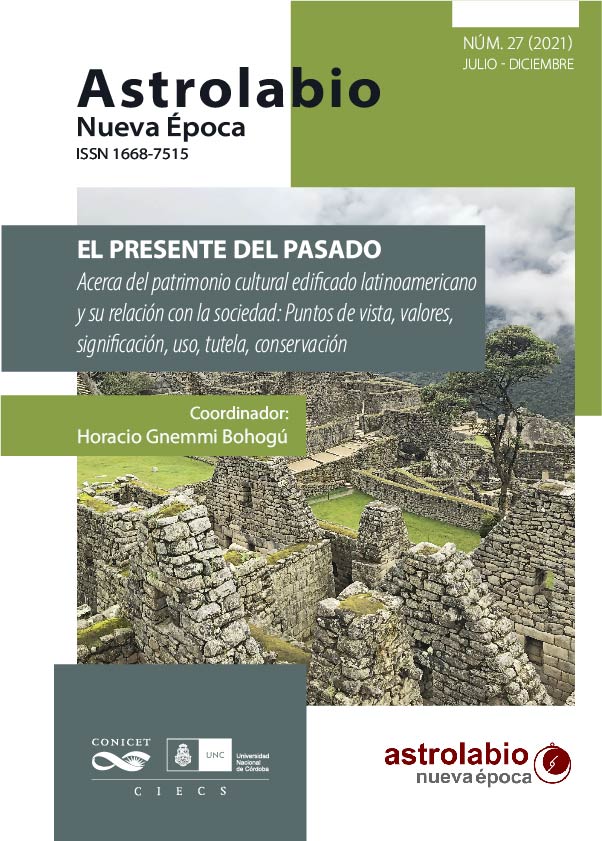Art, technique and metal craft. Ornamental metal works in Montevideo´s architectural heritage, 1780-1950
Main Article Content
Abstract
This article summarizes some aspects of the project “Iron and bronze. Criteria for the valuation and conservation of ornamental metalworks in the architectural heritage of Uruguay”, whose objective is to establish the heritage attributes of the metallic ornamental elements associated with facades of the national architectural heritage and contribute to their dissemination, enhancement, and conservation. Throughout the research, socio-cultural, artistic, formal, and technical aspects are addressed, and finally, those related to the deterioration of these elements and the guidelines for their preservation and restoration.
The methodology is based on the study of primary sources, published and unpublished, on the revision of specialized bibliography and on the site work on a representative sample of metallic ornamental elements applied to the facades of Montevideo architecture. A total of 250 buildings were surveyed, corresponding to the different periods that we distinguished in the evolution of the local ornamental metalwork between the end of the 18th century and the middle of the 20th century. It is an initial contribution that delves into a field that is scarcely studied in our environment about the knowledge and dissemination of metalwork in the context of the Uruguayan architectural and artistic heritage, providing useful information to the academy, the institutions linked to the valuation and heritage conservation and the general public.
Article Details
Section

This work is licensed under a Creative Commons Attribution-NonCommercial-ShareAlike 4.0 International License.
Astrolabio, Nueva Época está protegida bajo licencia Licencia Creative Commons Atribución-NoComercial-CompartirIgual 4.0 Internacional. La propiedad intelectual de los artículos pertenece a los autores y los derechos de edición y publicación a la revista. Los artículos publicados podrán ser usados libremente para propósitos científicos y académicos, siempre y cuando se realice una correcta citación de los mismos. Cualquier persona física o jurídica que desee reimprimir parte o la totalidad de algún artículo, deberá obtener permiso escrito de los editores de Astrolabio Nueva Época, quien lo otorgará con el consentimiento del autor.
How to Cite
References
ACEVEDO, Eduardo. (1934). Anales históricos del Uruguay. Tomo V. Montevideo: Barreiro y Ramos.
ANTOLA, Susana; GALBIATI, Mary; MAZZINI, Elena; MORENO, Jorge; y PONTE, Cecilia. (1994). El aporte italiano a la imagen de Montevideo a través de la vivienda. Montevideo: Instituto Italiano di Cultura.
ARANA, Mariano; MAZZINI, Andrés; PONTE, Cecilia; y SCHELOTTO, Salvador. (1999). Arquitectura y diseño art déco en el Uruguay. Montevideo: Dos Puntos.
APOLANT, Juan Alejandro. (1966). Génesis de la familia uruguaya. Montevideo: Instituto Histórico y Geográfico.
ARREDONDO, Horacio. (1951). Civilización del Uruguay. Aspectos arqueológicos y sociológicos 1600-1900, Tomos I y II. Montevideo: El Siglo Ilustrado.
BOZAL, Valeriano. (1999). El gusto. Madrid: Visor.
CASTELLANOS, Alfredo. (1958). “Cronología”. Revista del Museo Blanes, 1, 1-17.
DRURY, Elizabeth. (1991). Antigüedades. Técnicas artesanales tradicionales. Barcelona: Folio.
FERNÁNDEZ SALDAÑA, José María. (1945). Diccionario uruguayo de biografías 1810-1940. Montevideo: Linardi y Risso.
GRÜNWALDT, Jorge. (1970). Vida, industria y comercio en Montevideo (1830-1852). Montevideo: Barreiro y Ramos.
LOS CIEN CARPINTEROS Y HERREROS. (1837). Contestación de los cien carpinteros y herreros al ex-redactor del Defensor. Montevideo: Imprenta Oriental.
MANG, Andrés. (1908). Catálogo herrería artística y de obra. Montevideo: El Arte, Talleres gráficos de O. M. Bertani
PÉREZ MONTERO, Carlos. (1950). El Cabildo de Montevideo. Montevideo: Imprenta Nacional.
TOMÉ, ANTONIO. (1860). Registro estadístico de la República Oriental del Uruguay. Montevideo: La República.

